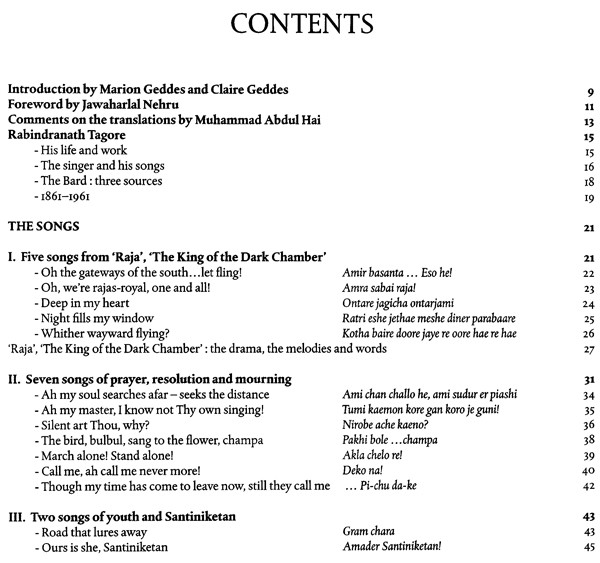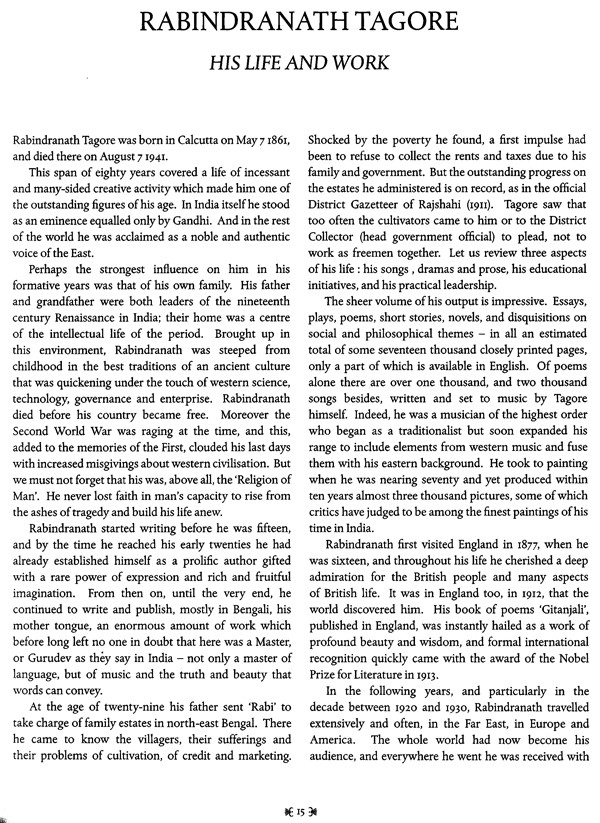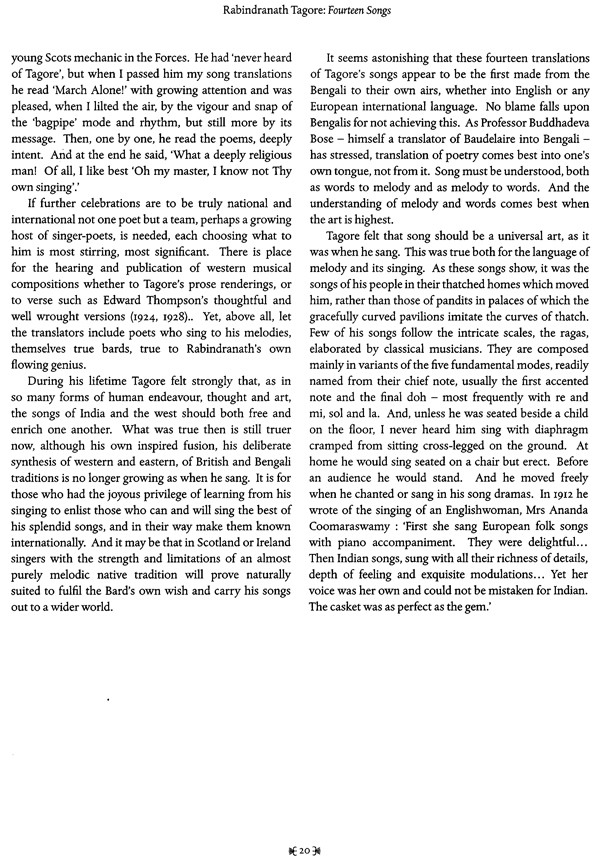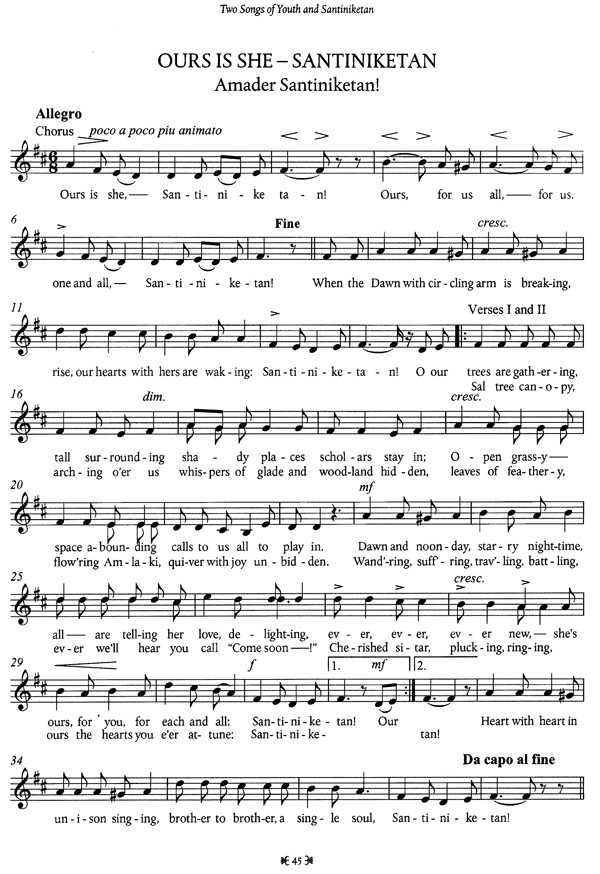
Fourteen Songs
Book Specification
| Item Code: | NBZ710 |
| Author: | Arthur Geddes |
| Publisher: | Visva-Bharati, Kolkata |
| Language: | English |
| ISBN: | 9788175225640 |
| Pages: | 46 |
| Cover: | PAPERBACK |
| Other Details | 11.00 X 9.00 inch |
| Weight | 290 gm |
Book Description
In the text that accompanies the songs, Arthur Geddes discusses the life and work of Tagore, the sources from which the poet took his inspiration, and the translator's own efforts in trying not only to faithfully translate Tagore's words but to convey the imagery, rhythms and verse forms of the originals.
The fourteen songs are presented in modern musical notation for singers and instrumentalists, divided into three sections:
- Five songs from the song-drama 'Raja' (The King of the Dark Chamber')
- Seven songs of prayer, resolution and mourning
- Two songs of youth and Santiniketan
Arthur Geddes (1895-1968) lived in India from 1921 to 1924, assisting the rural reconstruction projects of Rabindranath Tagore at Sriniketan in West Bengal and the town-planning work of his father Patrick Geddes in other parts of India. The geography of Bengal was the subject of his doctoral thesis 'Au Pays de Tagore' (In the Land of Tagore') submitted at the University of Montpellier, France. In 1927 he returned to Scotland and worked in the Department of Geography at Edinburgh University until 1965. He died before completing this book. It has now been edited by two of his daughters, Marion and Claire Geddes. 'Tagore was essentially a singer and it is perhaps easier to understand him through his songs than through his writings.... To us in India, he is looked upon as one of the Rishis or Seers of old who carried on the ancient tradition in modern times.' - Jawaharlal Nehru, Prime Minister of India (1947-1964)
What is remarkable about this volume is that the songs are not just authentic translations conveying the spirit of Tagore's words, but are 'singable'. This book will allow Tagore's songs to transcend Indian borders and bring them to an international audience, reaffirming Tagore as an international poet and song-writer. - Bashabi Fraser, poet and writer
Tagore was a remarkable and full-sided personality and the appreciation of his writings and of him as a man has continued to grow all over the world. In India he is known as Gurudev, the great teacher, and his best memorial is the University he founded in Santiniketan. One of his songs has become the National Anthem of India ever since independence. In Bengal he is particularly known and loved because of his songs which have gone down to the villages. The partition of India and Bengal has not affected in any way the great appreciation of his writings, and especially his songs, in both parts of Bengal. To us in India, he is looked upon as one of the Rishis or Seers of old who carried on the ancient tradition in modern times. His influence over successive generations has been very great, even though it has not had the glamour and publicity attached to the successful politician; yet his influence was much deeper and will continue when the politician's name is hardly remembered.
Tagore and Gandhi overlapped for many years and were the outstanding representatives of India. They were different in many ways and sometimes criticised each other's views and activities, but yet they were drawn to each other, and each of them had great regard and affection for the other. It was fascinating to see these two men of great stature, representing different aspects of India, and both of them even though appreciating and understanding many modern trends yet representing fundamentally the old spirit of India.
Tagore was essentially a singer and it is perhaps easier to understand him through his songs than through his writings. I welcome, therefore, this publication by Dr Geddes and hope this will make the spirit of Tagore better known in West and East.
From 1921 to 1924 Arthur Geddes was in India assisting the town-planning work of his father Patrick Geddes, and the rural reconstruction projects of Rabindranath Tagore at Sriniketan. It was during this period that he learned Bengali, sang and made notations of some of Tagore's songs and played the melodies on his violin. He later graduated in geography and published his doctoral thesis 'Au Pays de Tagore' at the University of Montpellier, France, where from 1925 to 1927 he was also contributing to his father's work at the College des Ecossais. He then returned to his native Scotland and worked in the Department of Geography at Edinburgh University until 1965. During this time he published many research papers on the human geography of India. Some of these papers were incorporated in a book, unfinished at the time of his death but subsequently edited by Professor A.T.M. Learmonth et al and published as 'Man and Land in South Asia' (Concept Publishing Company, New Delhi 1982).
He greatly admired Rabindranath Tagore and continued to share and raise awareness of Tagore's poems and songs at home and abroad. We hope that our father's rendering of Tagore's songs in this publication will bring pleasure to new audiences.
Book's Contents and Sample Pages










